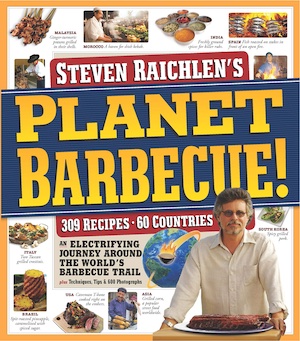By Isaac Hughes
Despite the many differences that exist between us humans, one thing connects us all: the need to eat.
Because of this unavoidable nature of food, it is possible to assume that cooking is a task that is basic or rudimentary, involving little need for introspection. For New York Times Bestselling food author Steven Raichlen (ΦBK, Reed College), the opposite is true.
In fact, Raichlen has committed his career to studying the various intersections between the food that we cook and the many contexts that surround it.
Graduating from Reed College with a degree in French literature, Raichlen knew he wanted to further explore two of his favorite subjects: food and French history. These tandem desires are what led to Raichlen’s Watson Foundation Fellowship in Europe, where he studied medieval cooking.
While abroad, Raichlen also took French cooking classes at La Varenne and Le Cordon Bleu in Paris. It was essential not only to study the food from a historical lens, he explained, but also to master the modern cooking techniques that developed over a span of centuries.
“When you look at a medieval cooking manuscript, basically it says, ‘take this, that, and the other and bind it in the customary fashion,’” he said. “I didn’t know what the customary fashion was. So I figured that if I took a modern French cooking class, I could learn how the system of cooking works—in a way, learn the grammar of cooking.”
This realization that the study of food necessarily involves both a theoretical and practical understanding has served Raichlen throughout his career. In fact, as a writer of dozens of cookbooks, many of them on the topic of grilling, Raichlen has always advocated for the importance of the cultural context around the recipes that he creates. This is because every recipe comes steeped in the culture that generated it.
“In some countries, grilling is so deeply enmeshed in the culture that if you were to take that away it would be like taking soccer away from Brazil,” said Raichlen.
In his crafting of the prose that surrounds a recipe, Raichlen applies this cultural understanding. While heacknowledges that most people buy cookbooks for the recipes, Raichlen treats the text that surrounds each recipe just as seriously and astutely as the recipe itself.
Perhaps one of the best examples of Raichlen’s love for writing comes not from his work as a cookbook writer, but as a novelist. During a period when his cookbook editor was on sick leave, Raichlen found a window of time to write The Hermit of Chappaquiddick, a novel detailing the romance between a New York book editor and a mysterious man on the island known simply as The Hermit. While there are no recipes in this book, both characters use cooking as a means of building their relationship.
As a result of writing this novel, Raichlen was able to further hone his creative writing abilities in new and exciting ways.
“With writing cookbooks, you always have facts to anchor yourself to . . . with fiction, you are always out in the air,” he said. “Everything is made up, and it can be based on things, but what happens in the story is something you create, and I loved that aspect of being the creator of a universe.”
The creative challenge of writing fiction, Raichlen said, improved his food writing.
“It made me think even more about the stories behind dishes than I have in the past,” he said.
Whether it be in his cookbooks, TV shows, or other adventures in the culinary realm, there is a major throughline in Raichlen’s life: an undeniable love for learning, writing in all its forms, and how the well-crafted use of the written word is a tool that is just as important in the kitchen as a sharp chef’s knife.

Hungry for more? Try making the Caveman T-bone, a recipe chosen by Raichlen as best exemplifying his love for food and food scholarship. Here’s what he says about the dish:
“I created the Caveman T-bone for my book Planet Barbecue (Workman Publishing, 2010), and it has become the perfect symbol for my approach to grilling and writing. It pays homage to a distant human ancestor called Homo erectus, who roughly 1.8 million years ago used fire to cook meat, thereby inventing the art of cooking—and dare I say civilization itself. In a nutshell, you grill a thick T-bone steak directly on blazing embers, so as you can imagine, the theatrics are off the chart. But there’s more to “caveman grilling method that just showmanship, as the embers give the meat a surface charring and smoke flavor you just can’t duplicate on a conventional grill. To that add an electrifying sauce of pan-fried jalapeños, cilantro, and garlic, and you’ve got a steak that roars off the plate with flavor. It’s guaranteed to awaken the inner caveman in all of us.” — Steven Raichlen
Isaac Hughes is a recent graduate of Knox College, where he majored in environmental studies and philosophy. He was inducted to Phi Beta Kappa as a junior in 2020.




